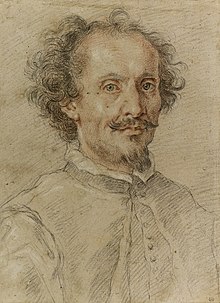|
Agostino Mascardi
Agostino Mascardi (2 September 1590 – 1640) was an Italian rhetorician, historian and poet. Expelled from the Jesuit Order by his superiors, Mascardi pursued a successful career as a secretary for various important figures, and became a renowned writer and professor of rhetoric at the Sapienza University of Rome. He was a member of several learned societies and wrote a seminal treatise, "Dell'arte historica" (1636) advocating history as a powerful instrument of ethical and religious persuasion and largely focusing on the interplay between truth and believability. BiographyBorn in Sarzana in Liguria, Mascardi studied in Rome and was ordained a Jesuit, but was expelled from the Order in 1617.[1] According to Mascardi, “the principal reason of such calamity has been my employment with the House of Este,” which his Jesuit superiors saw as a sign that Mascardi had decided to put his personal ambitions before the interests of the Jesuit order.[2] His fruitful career continued, however, with a degree in jurisprudence and several posts as secretary to important political and religious personalities including Cardinals Alessandro d'Este and Maurice of Savoy.[1] Mascardi's writing attracted the attention of Pope Urban VIII who appointed him chamberlain and in 1628 gave him the position of Professor of Rhetoric at the University of Rome in the College of the Sapienza.[3] He was a member and later principe of the Accademia degli Umoristi and sopraintendente of the Accademia dei Desiosi, which started to be assembled by Prince Maurice of Savoy in 1625 and was officially founded in 1626, and which became one of the most intellectually vivacious venues in early seventeenth-century Rome.[4][5] In 1640, four years after the publication of his masterpiece Dell'arte historica, Mascardi decided to leave Rome and move back to his native Liguria. Old and sick, he died shortly after his arrival there.[6] Gian Lorenzo Bernini realized two portraits of Mascardi. One is a painting, now lost, which once belonged to Cassiano dal Pozzo. The other is a drawing of 1630, known through another conserved in Paris at the l'École des Beaux-Arts.[7] Dell'arte historicaMascardi was a foremost theorist for the new historiography, which grew out of the Counter-Reformation need to assimilate the goals of history with those of religious propaganda. He and Francesco Sforza Pallavicino promoted history as a major instrument of ethical and religious persuasion. Mascardi's treatise Dell'arte historica (1636) covers the origins, the ancient sources, the material and the goals of history. Much of the second and third books of the treatise investigate the relationship between truth (“vero”) and verisimilar (“verisimile”). The fourth and fifth books deal with technical matters, including a long discussion of style (“stile”). Mascardi taught his readers that history was essentially a problem of style and considered history as a branch of oratory – the opus oratorium maxime.[8] Accordingly, at the beginning of Book V, Mascardi asserts the “convenienza dell'istoria con la poesia e con l'oratoria.” Underlying the entire work is the premise that history, using the methodology of rhetoric, can be a powerful persuasive means.[9] Gabriel Naudé lauds Mascardi's treatise on the art of history for its “matchless elegance in language and for its judicious treatment of its subject.”[10] Siluarum libri IV The title of Mascardi's publication was very likely inspired by the Silvae of Publius Papinius Statius (ca. 45-96 A.D.) which is a collection of topical poems (epigrams, letters, satires, poems for weddings, odes, funeral poems, etc. ) partly based on Virgil. Mascardi's Silvae also contained poems concerned with a variety of themes, and his publication is divided into four Books. Book I, De Rebus Heroicis (On heroic events), consists of poems honouring victories in battle, the achieving of peace, various heroic figures from antiquity (Romulus, Hannibal, Clelia, Cleopatra, etc.) and modern history (Cardinals Alessandro d'Este, Maffeo Barberini, Aloysius Capponius, etc.). The second Book has no subtitle and includes three elegies on Queen Dido, three poems on the seasons, two on poverty and others on varied subjects. Book III, De Rebus Tristibus (On mournful events), has several poems concerning funerals. For example, there is an eclogue which contains a dialogue between two shepherds who discuss the death of Margaret of Austria. Still other poems are devoted to the funerals of famous contemporaries or are concerned with the fugacity of time. The volume closes with Book IV, De Rebus Sacris (On sacred matters), which presents a variety of poems dealing with religious themes.[citation needed] Mascardi's Silvae was the “first book [of] contemporary poetry illustrated with a title-page by Rubens”.[11] Works
Notes
Bibliography
External linksWikimedia Commons has media related to Agostino Mascardi.
|
||||||||||||||||||||||||||||||
